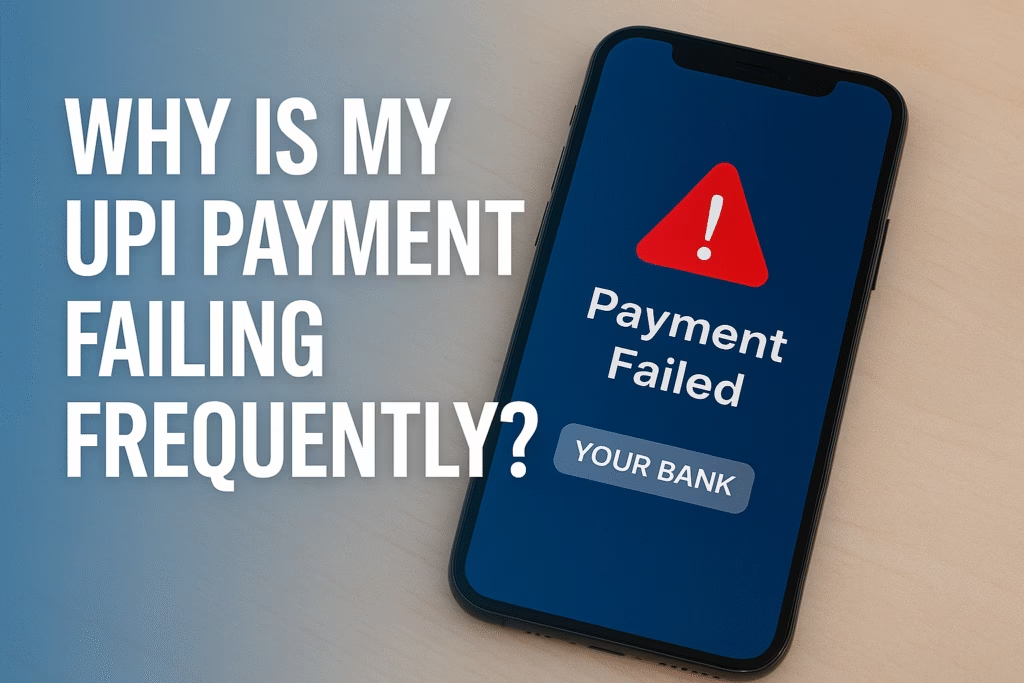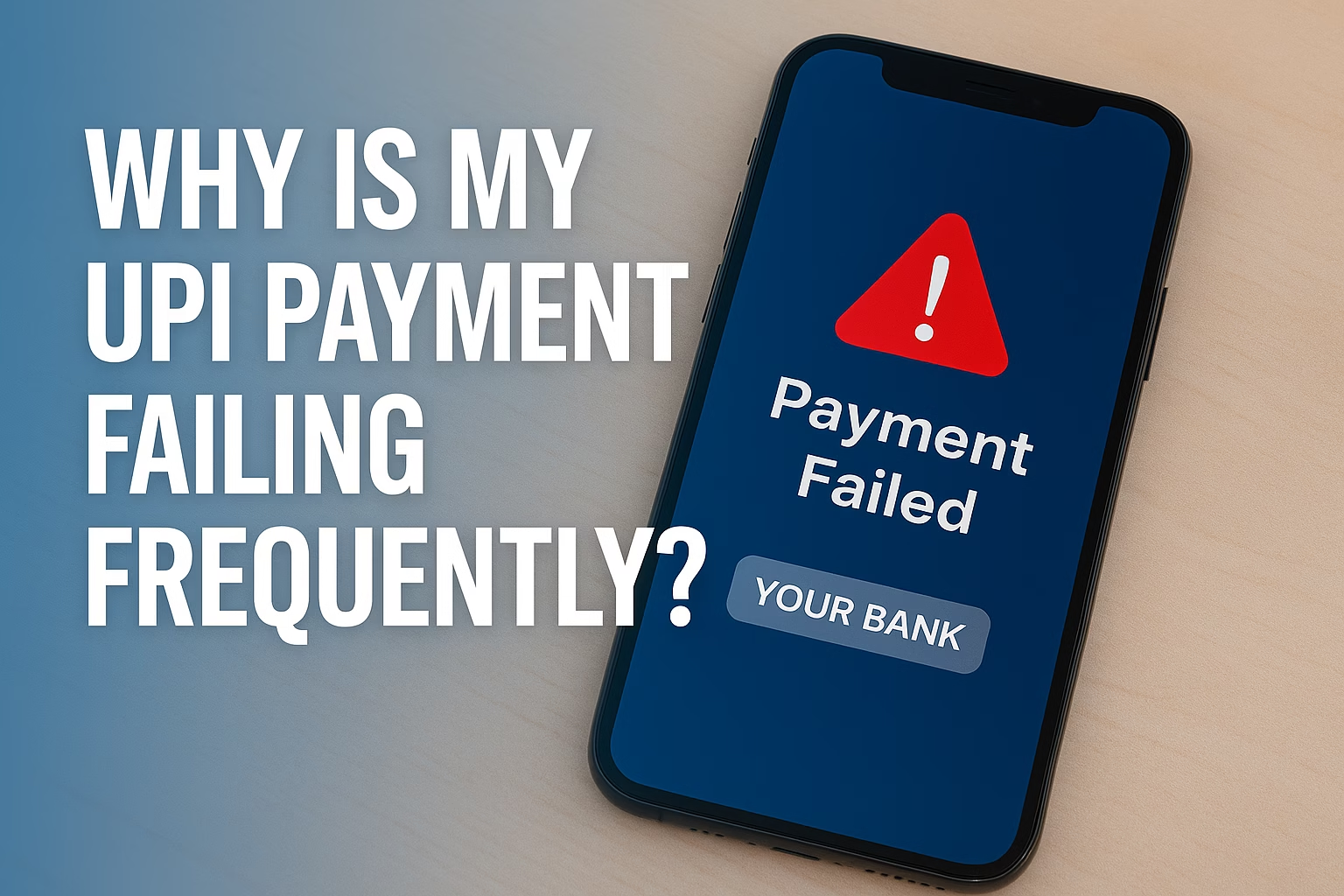Introduction
In 2025, From splitting dinner bills to paying rent or shopping online, UPI is now everywhere. But what happens when you’re standing at a counter and that dreadful “Payment Failed” screen shows up again?

If you’re frustrated by repeated UPI payment failures, you’re not alone. While the UPI system is fast and mostly reliable, many users are facing growing issues with failed payments, delays, or money getting stuck in limbo. What makes it worse is that there’s very little transparent information out there.
So let’s break it down: Why is your UPI payment failure so often? What can you do about it? And are there ways to avoid these headaches altogether?
1. Server Downtime – The Most Common Cause
If you’re using Google Pay, PhonePe, Paytm, BHIM, or any UPI app, chances are your payment failed because either your bank’s server or the UPI app’s server is temporarily down or overloaded.
Even if you have money in your account and good internet, your UPI payment failure because the app couldn’t connect with your bank to authorize the transaction.
❗How to check?
- Visit the NPCI UPI status page to see real-time downtime of bank servers.
- Some UPI apps now notify users if a bank is facing issues.
✅ What you can do:
- Try again after a few minutes.
- Switch to a different UPI app.
- Use a another bank account which added to your UPI.
2. Your Bank May Be the Problem
Certain banks consistently report higher UPI payment failure rates. Smaller cooperative banks or even some PSU banks may not have updated infrastructure to handle real-time UPI loads.
Example:
A user using a rural bank often faces delays or “failed” messages even when everything else is working.
✅ What you can do:
- Use accounts from banks with better digital infrastructure like HDFC, ICICI, SBI, Axis, or Kotak.
- Avoid using smaller regional banks for high-volume UPI transfers.
3. Cross-App UPI Conflicts
Did you switch between PhonePe and GPay with the same number? That might cause conflicts in VPA (Virtual Payment Address). Sometimes, two apps linked to the same number cause routing issues for payments.
✅ What you can do:
- Stick to one primary UPI app for your major bank account.
- Make sure VPAs aren’t duplicated or mismatched.
4. Exceeding Daily Transaction Limits
Each bank and UPI app sets daily transaction limits. If you’ve hit the limit for number of transactions or amount (₹1 lakh/day in most cases), your further transactions will fail.
This is one of the lesser-known reasons for frequent UPI payment failure.
✅ What you can do:
- Check your daily UPI limit in the app or bank.
- Try another bank account if you’ve reached the limit.
5. KYC and Account Verification Issues
If your UPI account or the app hasn’t completed KYC (Know Your Customer), you may start facing restrictions like failed or delayed payments. Some users never realize their account is “partially active” or “under review.”
✅ What you can do:
- Complete full KYC on Paytm, PhonePe, etc.
- Make sure your SIM is in the device you’re using to register.
6. SIM Binding or Device Change
If you changed your SIM card, ported numbers, or switched phones recently, the UPI platform may not recognize your device. This results in failed verification and eventually UPI payment failure.
✅ What you can do:
- Re-register UPI with your current device and number.
- Avoid using dual SIM phones with multiple banks assigned to different numbers.
7. Poor Internet Connectivity
A simple one, but very often overlooked: low-speed or unstable internet—especially in crowded or remote areas—can cause failed transactions, especially during OTP or PIN entry.
✅ What you can do:
- Switch to mobile data if WiFi is weak.
- Avoid making payments in low network zones.
8. QR Code or UPI ID Errors
Manually entering the wrong UPI ID, scanning a damaged or expired QR code, or scanning personal UPI QR codes for merchant transactions can result in UPI payment failure.
✅ What you can do:
- Always verify the UPI ID before sending money.
- Prefer official merchant QR codes (they’re different from personal ones).
9. Backend Delays from NPCI
Sometimes, even when banks and apps are working fine, NPCI (National Payments Corporation of India), which runs the UPI infrastructure, faces bottlenecks due to sudden traffic spikes (like salary days, sales, etc.)
This may result in timeouts or pending transactions.
10. Suspicious Activity Flagged by Bank
If you’ve made too many small-value transactions, used unfamiliar devices, or shown inconsistent UPI usage patterns, banks may block or delay your payments due to risk detection.
✅ What you can do:
- Avoid unusual payment behaviors.
- Contact bank support if your UPI is blocked or restricted.
What Happens to the Money After UPI Payment Failure?
Good news: Most of the time, if money is debited from your account but the transaction fails, it is automatically reversed within 5 working days.
But let’s be honest — waiting 5 days for your money can be stressful, especially during emergencies.
How to Get Refund Faster
- Raise a dispute directly within the UPI app (PhonePe, GPay, Paytm).
- Use the Help section and attach screenshots of the failed transaction.
- If the app support doesn’t respond, raise a complaint at NPCI’s Dispute Redressal Portal.
Tips to Avoid UPI Payment Failure
| Problem | Solution |
|---|---|
| Bank server down | Use a different bank account |
| Network issues | Switch between mobile data and Wi-Fi |
| UPI daily limit reached | Use another bank account or wait 24 hours |
| KYC incomplete | Complete full KYC on the app |
| SIM mismatch/device switch | Rebind SIM and register UPI again |
| High UPI traffic hours | Avoid transactions between 10 AM–12 PM and 6 PM–9 PM |
| Damaged QR/incorrect UPI ID | Double-check before paying |
Smart Meters in India: How They Work, Benefits, and What You Must Know in 2025
Final Thoughts
UPI payment failure is frustrating, especially when it happens at the worst time. But understanding the real reasons—server issues, banking restrictions, and app glitches—can help you navigate this better.
While UPI remains one of India’s most successful digital revolutions, it’s still evolving. As infrastructure improves, many of these issues will reduce. But for now, being aware of the causes and having quick solutions can save you time, stress, and your hard-earned money.
Key Takeaways:
- Most UPI payment failures are due to server downtime or app-bank sync issues.
- Use reliable banks and keep your UPI KYC updated.
- Avoid peak hours and stay within daily limits.
- Raise complaints through the app or NPCI if refunds are delayed.
🔍 Remember: Next time you see “Transaction Failed,” don’t panic. The problem is likely fixable, and now—you know how to deal with it.

